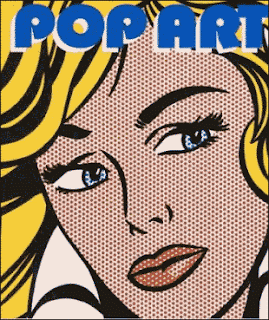An art movement and style that had its origins in England in the 1950s and made its way to the United States during the 1960s. Pop artistshave focused attention upon familiar images of the popular culture such as billboards, comic strips, magazine advertisements, and supermarket products. Leading exponents are Richard Hamilton (British, 1922-), Andy Warhol (American, 1928?1930?-1987), Roy Lichtenstein (American, 1923-1997), Claes Oldenburg (American, 1929-), Jasper Johns (American, 1930-), and Robert Rauschenberg (American, 1925-).
Pop art employs aspects of mass culture, such as advertising, comic books and mundane cultural objects. It is widely interpreted as a reaction to the then-dominant ideas of abstract expressionism, as well as an expansion upon them. And due to its utilization of found objects and images it is similar to Dada. Pop art is aimed to employ images of popular as opposed to elitist culture in art, emphasizing the banal or kitschy elements of any given culture, most often through the use of irony. It is also associated with the artists' use of mechanical means of reproduction or rendering techniques.
Much of pop art is considered incongruent, as the conceptual practices that are often used make it difficult for some to readily comprehend. Pop art and minimalism are considered to be art movements that precede postmodern art, or are some of the earliest examples of Postmodern Art themselves.
Pop art often takes as its imagery that which is currently in use in advertising. Product labeling and logos figure prominently in the imagery chosen by pop artists, like in the Campbell's Soup Cans labels, by Andy Warhol. Even the labeling on the shipping carton containing retail items has been used as subject matter in pop art, for example in Warhol's Campbell's Tomato Juice Box 1964, (pictured below), or his Brillo Soap Box sculptures.
The origins of pop art in North America and Great Britain developed differently. In the United States, it marked a return to hard-edged composition and representational art as a response by artists using impersonal, mundane reality, irony and parody to defuse the personal symbolism and "painterly looseness" of Abstract Expressionism. By contrast, the origin in post-War Britain, while employing irony and parody, was more academic with a focus on the dynamic and paradoxical imagery of American popular culture as powerful, manipulative symbolic devices that were affecting whole patterns of life, while improving prosperity of a society.Early pop art in Britain was a matter of ideas fueled by American popular culture viewed from afar, while the American artists were inspired by the experience of living within that culture.Similarly, pop art was both an extension and a repudiation of Dadaism. While pop art and Dadaism explored some of the same subjects, pop art replaced the destructive, satirical, and anarchic impulses of the Dada movement with detached affirmation of the artifacts of mass culture. Among those artists seen by some as producing work leading up to Pop art are Pablo Picasso, Marcel Duchamp, Kurt Schwitters, and Man Ray.
Sir Eduardo Luigi Paolozzi was born 7 March 1924, in Leith in north Edinburgh, Scotland and was the eldest son ofItalian immigrants. In June 1940, when Italy declared war on Britain, Paolozzi was interned (along with most other Italian men in Britain). During his three-month internment at Saughton prison his father, grandfather and uncle, who had also been detained, were among the 446 Italians who drowned when the ship carrying them to Canada, the Arandora Star, was sunk by a German U-boat.
Paolozzi studied at the Edinburgh College of Art in 1943, briefly at the St Martin's School of Art in 1944, and then at the Slade School of Fine Art at University College London from 1944 to 1947, after which he worked in Paris, France. While in Paris from 1947–1949, Paolozzi became acquainted with Alberto Giacometti, Jean Arp, Constantin Brâncuşi, Georges Braque and Fernand Léger. This period became an important influence for his later work.















.jpg)
.jpg)


